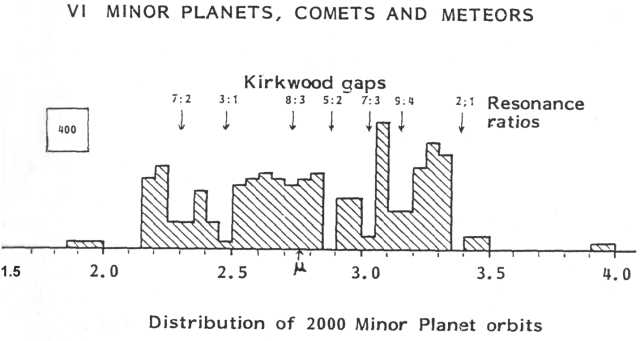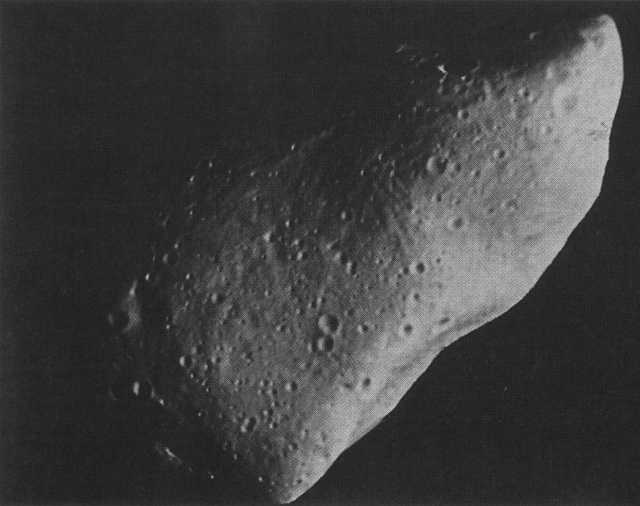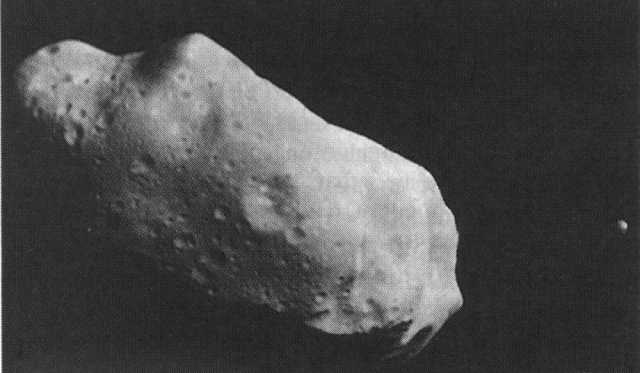
The International Astronomical
Union has decided that these small bodies must be called minor planets and not
asteroids as they have nothing to do with stars.
When William Herschel discovered
Uranus, the first new planet to be discovered in modern times, astronomers were
fired UD to search for new planets. Nine
years before the discovery of Uranus, Johann Bode fixed attention to a
"rule" which Johann Titius had annotated in a book by Karl Bonnet in
which the relative distances of the planets from the Sun figured..
The "rule" begins with zero, then
3, followed by 6, 12...doubling each time.
To each term 4 was added and then each term was divided by 10.
|
Series |
+ 4 |
÷
10 |
AU |
Planet |
|
0 |
4 |
0,4 |
0,387 |
Mercury |
|
3 |
7 |
0,7 |
0,725 |
Venus |
|
6 |
10 |
1,0 |
1,0 |
Earth |
|
12 |
16 |
1,6 |
1,524 |
Mars |
|
24 |
28 |
2,8 |
? |
Missing |
|
48 |
52 |
5,2 |
5,2 |
JUPITER |
|
96 |
100 |
10,0 |
9,54 |
Saturn |
|
192 |
196 |
19,6 |
19,19 |
Uranus |
The values of the “rules” are
close to the actual relative distances of the planets from the Sun.
Earth and Jupiter are dead exact. But
there is no planet corresponding to the value 2,8.
So it was concluded that there must be a planet at this distance of 2,8
AU but that it was missing. So the
astronomers fine combed the strip of sky covered by the Signs of the Zodiac,
astride the ecliptic. And great was
the excitement when G Piazzi announced on 1 January 1801 that he had discovered
a planet which was in such an orbit that It would take
4,61 years to go around the Sun. The
square of 4,61, i.e. T2 is 21,521, and the cube root of this value is
2.77 and this must be the value of the distance R from the Sun because T2
must equal R3 according to Kepler's Third Law. This value 2.77 was very close to 2,8 of the "rule"
The new planet was called 1 CERES. Its
orbit was found to have an inclination to the ecliptic of 10° 36' 28" but
nobody took exception-to that.
On 28 March 1802 H W H Olbers
discovered a second planet whose distance also worked out at 2,77 AU.
The inclination of its orbit was found to be no less than 34° 43'
09" and it was called 2 PALLAS. And
on 1 September 1804 K L Harding discovered a third planet at an average distance
from the Sun of 2,67 AU. It was
called 3 JUNO.
The cup overflowed when Olbers
discovered his second planet on 22 March 1807 with an inclination of only 7° 7'
55,7" to the ecliptic. But its
average distance from the Sun worked out at 2,36 AU, now deviating considerably
from the "rule". It was
called 4 VESTA.
By the end of 1850
another nine minor planets had been discovered; another 21 before 1Q55
and another 24 before 1350. So the
total of 58 had been reached by 1360. Today
the number exceeds 3000 of which the orbits have been calculated and tested
for perihelion distances on at least three passages through perihelion..
And there are many thousands more that have since been discovered.
1 Ceres, the first discovered, is
the largest, being 1000 km in diameter. Second
largest is 2 Pallas, 508 km in diameter; then 4 Vesta 538 km; Higea 450 km;
Euphrosine 370 km; Interamnia 350 km; Davida 323 km and Cibeline 309 km.
There are 18 with diameters between 300 and 200 km; 41 between 200 and
100 km and the rest are smaller than 100 km.
The best way of measuring these small diameters is to time the
occultation of a star by the minor planet.
Such an occultation was monitored by Johannesburg amateur astronomers T
Cooper, B Fraser, H Lund, the late Danie Overbeek and J Smit.
They measured the times of vanishing and reappearance of the minor planet
248 Lameia. The times of
occultation varied from 2 to 5,8 seconds. From
these values it was found that the diameter had values of 52 and 55 km, the
planet being oval in shape.
The diameter of the largest,
Ceres is only 0,29 that of the Moon. The
total mass of all the thousands of planetoids has been calculated to be only
1/3000 that of the Earth and 1/37 that of the Moon.
The smallest so far identified are as large as very big houses.
Many meteorites that have fallen on the Earth are minor planets.
If a house-sized body struck a built-up area, the damage would be
frightful.
The greatest brightness is
displayed by Vesta which has a magnitude of only 6,5, only just beyond
visibility by the naked eye. Ceres
must have a darker surface because its magnitude is 7,4 despite the fact that it
is much larger than Vesta. All the
rest are very much dimmer.

Many Minor Planets have orbits
that cut across that of the Earth. They
are called Earth Grazers. It was
probably an Earth Grazer that collided with the Earth 65 million years ago,
which collision led to the wiping out of 90% of the life forms then existing.
All that survived were small mammals such as rats, mice, squirrels and
hares, from these all the present
day life forms evolved, including you and me!
On 30 October 1937 the minor
planet called Hermes came to within 890 000 km of the Earth.
After that it was never seen again.
It has probably crashed into Venus or Mercury or most probably into the
Sun. Apollo and Adonis have
perihelions within the orbit of Venus. Icarus
comes closest to the Sun, 0,187 AU and thus nearer than the perihelion of
Mercury. Today an extensive watch
is being conducted to find Earth Grazers. Some
have been found that come closer than the Moon which is only 384 000 km
distant.. The best thing that we
can do is to have a rocket perpetually at the ready to be launched at a moment's
notice to go and push the Grazer into a safe orbit around the Earth, where we
will be able to go and mine its minerals! We cant say what minerals may be found there.
How did the Minor planets come
about? Some astronomers hold the
view that a smallish planet collided with another body of similar size which had
formed in orbit between Mars and Jupiter and this collision broke both planets
up into thousands of fragments which still exist today. This theory cannot explain how it is that Ceres is very
nearly spherical and how so many other Minor Planets are very nearly spherical.
For a solid body to be spherical it must by accretion be compacted
together. This happens when very
small particles overtake other small particles moving in orbits only slightly
further from the Sun. The inner
particle will be moving faster and will thus tend to overtake the outer particle
and in doing so the two particles will stick together. When
these planetesimals cleave together they become bigger and bigger and tend to
become spherical when they have diameters of 600 or more kilometres.
The moons of the planets are also subject to this limitation. Pallas which is 608 km wide is still rather oval.

The Minor Planet Gaspra which was
photographed by the space probe Galileo is covered by craters and its surface
seems covered by dust which must have been formed by micrometeorites pulverising
the surface.

At the distance where most minor planets revolve the gravitational influence of Jupiter must have had an influence when the planetesimals accreted together from the primeval nebula from which the Sun and all the other planets and their moons formed. This seems to be a better theory than the crash theory. Crashes in the universe are very rare. Think of Saturn's rings which were formed by Saturn's gravity breaking up one of the planet's icy moons. The fragments just go on revolving round the planet because the particles are in orbits which are ellipses of very low eccentricity. A collision would have sent the fragments flying in very elliptical orbits. If not in parabolas, never to return to the scene of the crash. Crashes indeed!
Jan Eben van Zyl